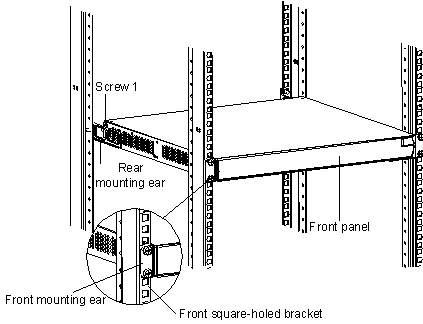- Table of Contents
- Related Documents
-
| Title | Size | Download |
|---|---|---|
| 01-Text | 993.08 KB |
1.2 S5510-24P-AC/S5510-24P-DC Ethernet Switch
1.3 S5510-24F-AC/S5510-24F-DC Ethernet Switch
1.4 Technical Specifications of S5510 Series
Chapter 2 Installation Preparation
2.2.3 Electromagnetic Susceptibility
Chapter 3 Installing the Switch
3.2.1 Installing a Power Module
3.3 Connecting the Power Cord and the Ground Wire
3.3.1 Connecting the AC-Input Power Cord
3.3.2 Connecting the DC-Input Power Cord
3.3.3 Connecting the Ground Wire
3.5 Connecting the Switch to a Console Terminal
3.5.2 Connecting the Console Cable
Chapter 4 Starting up the Switch at the Initial Boot
4.1 Setting up a Configuration Environment
4.2 Connecting the Console Cable
4.3 Setting Terminal Parameters
4.4.1 Verifying Installation before Power-up
Chapter 5 Loading Boot ROM and Host Software
5.1 Introduction to Loading Approaches
5.2.2 Loading Software from Console Port Using XModem
5.2.3 Loading Software from an Ethernet Port Using TFTP
5.2.4 Loading Software from an Ethernet Port Using FTP
5.3.1 Loading Software Remotely Using FTP
5.3.2 Loading Software Remotely Using TFTP
Chapter 6 Maintenance and Troubleshooting
6.1 Dealing with Loading Failures
6.2 Dealing with Password Loss
6.2.1 Dealing with User Password Loss
6.2.2 Recovering the Boot ROM Password
6.3 Dealing with Power System Failures
6.4 Dealing with Configuration System Failures
Chapter 1 Product Overview
1.1 Introduction
H3C S5510 Series Ethernet Switches (hereinafter referred to as S5510 series) are wire speed Layer 2/3 Ethernet switches developed by Hangzhou H3C Technologies Co., Ltd. They are intelligent network-manageable switches intended for network environments requiring high performance, dense port distribution, and ease of installation.
Table 1-1 lists the models in the S5510 series:
Table 1-1 Models in the S5510 series
|
Model |
Power supply |
Total service ports |
Port |
Console port |
|
H3C S5510-24P-AC |
AC-input |
28 (up to 24 can be used at the same time) |
24 x 10/100/1000 Mbps electrical ports 4 x 1000 Mbps Combo SFP ports |
1 |
|
H3C S5510-24P-DC |
DC-input |
28 (up to 24 can be used at the same time) |
24 x 10/100/1000 Mbps electrical ports 4 x 1000 Mbps Combo SFP ports |
1 |
|
H3C S5510-24F-AC |
AC-input |
28 (up to 24 can be used at the same time) |
24 x 1000 Mbps SFP ports 4 x 10/100/1000 Mbps Combo electrical ports |
1 |
|
H3C S5510-24F-DC |
DC-input |
28 (up to 24 can be used at the same time) |
24 x 1000 Mbps SFP ports 4 x 10/100/1000 Mbps Combo electrical ports |
1 |
The S5510 series provides two power slots on its rear panel: PWR1 and PWR2, and accommodates a power module in PWR1 and a dummy panel on PWR2 when leaving factory. In practice, you can choose an appropriate power module (AC or DC–input module) for PWR2 according to your needs, which is used for the redundancy of the module in PWR1.
1.2 S5510-24P-AC/S5510-24P-DC Ethernet Switch
1.2.1 Front Panel
I. Illustration
The S5510-24P-AC and S5510-24P-DC have the same front panel. On the front panel, the S5510-24P-AC/S5510-24P-DC provides 24 fixed 10/100/1000Base-T auto-negotiation Ethernet ports, four 1000 Mbps Combo SFP ports and one Console port, as shown in Figure 1-1.
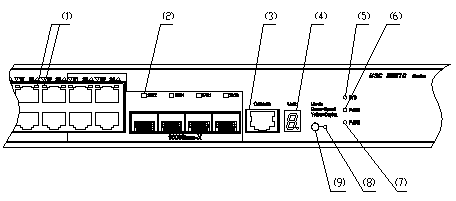
|
(1) 10/100/1000Base-T auto-negotiation Ethernet port status LEDs |
|
|
(2) 1000 Mbps SFP port status LEDs |
(3) Console port |
|
(4) 7-segment numerical display LED |
(5) Host status LED |
|
(6) Power module 1 status LED |
(7) Power module 2 status LED |
|
(8) Mode switch LED |
(9) Mode switch button |
Figure 1-1 Front panel of the S5510-24P-AC/S5510-24P-DC
Each of the four 1000 Mbps Combo SFP ports corresponds to a 10/100/1000Base-T auto-negotiation Ethernet port, so there are four pairs of associated ports, as show in Table 1-2. In each pair of ports, you can use only one port at a time.
|
Module |
Combo port |
Corresponding Ethernet port |
|
S5510-24P-AC/S5510-24P-DC |
25 |
22 |
|
26 |
24 |
|
|
27 |
21 |
|
|
28 |
23 |
II. LEDs
For your convenience to monitor the operation of the switch, the S5510-24P-AC/S5510-24P-DC provides one host status LED, two power module LEDs, one port mode switch LED, one 7-segment numerical display LED, 24 x 10/100/1000 Mbps Ethernet port status LEDs, four Combo SFP port status LEDs on its front panel. Table 1-3 describes the meanings of these LEDs:
Table 1-3 LEDs on the front panel of the S5510-24P-AC/S5510-24P-DC
|
LED |
Mark |
Status |
Meaning |
||
|
Mode switch LED |
Mode |
Speed |
Solid green |
The port status LEDs are showing their current port speeds. |
|
|
Duplex |
Solid yellow |
The port status LEDs are showing their current (full/half) duplex modes. |
|||
|
Host status LED |
SYS |
Solid green |
The switch works normally. |
||
|
Flashing green (at 1 Hz) |
The switch is running power-on self-test (POST) or is loading software. (1) When running POST, The system displays the number of current POST item on the 7-segment numerical display LED, for example:
(2) When loading software, the system lights the short bars one after another in clockwise direction on the 7-segment numerical display LED:
|
||||
|
Solid red |
The switch fan is in trouble. At this time, the system displays "F" on the 7-segment numerical display LED:
|
||||
|
Flashing red |
The system fails the POST and does not work. At this time, the system displays the number of the failed POST item on the 7-segment numerical display LED, for example:
|
||||
|
Flashing yellow (at 1 Hz) |
Some of the ports on the switch fails the POST and do not work. |
||||
|
OFF |
The switch is powered off. |
||||
|
Power module 1 LED |
PWR1 |
Solid green |
The power slot 1 accommodates a power module, which is working normally. |
||
|
Solid yellow |
The power slot 1 accommodates a power module, which is not used now. |
||||
|
Solid red |
The power slot 1 accommodates a power module, which is in trouble now. |
||||
|
OFF |
The power slot 1 does not accommodate a power module. |
||||
|
Power module 2 LED |
PWR2 |
Solid green |
The power slot 2 accommodates a power module, which is working normally. |
||
|
Solid yellow |
The power slot 2 accommodates a power module, which is not used now. |
||||
|
Solid red |
The power slot 2 accommodates a power module, which is in trouble now. |
||||
|
OFF |
The power slot 2 does not accommodate a power module. |
||||
|
7-segment numerical display LED |
Unit |
In the process of POST |
The number of current POST item is displayed.
|
||
|
POST failure |
The number of the failed POST item is displayed.
|
||||
|
Loading software |
The short bars are lighted one after another in clockwise direction during the loading.
|
||||
|
Fan failure |
"F" is displayed.
|
||||
|
10/100/1000Base-T Ethernet port status LED |
— |
In speed mode |
Green |
The port works at 1000 Mbps; when it receives/sends data, the LED flashes quickly. |
|
|
Yellow |
The port works at 10/100 Mbps; when it receives/sends data, the LED flashes quickly. |
||||
|
Flashing yellow (at 3 Hz) |
The port fails the POST. |
||||
|
OFF |
The port is disconnected. |
||||
|
In duplex mode |
Green |
The port works in full duplex mode; when it receives/sends data, the LED flashes quickly. |
|||
|
Yellow |
The port works in half duplex mode; when it receives/sends data, the LED flashes quickly. |
||||
|
Flashing yellow (at 3 Hz) |
The port fails the POST. |
||||
|
OFF |
The port is disconnected. |
||||
|
1000Base SFP port status LED |
— |
In speed mode |
Green |
The port works at 1000 Mbps; when it receives/sends data, the LED flashes quickly. |
|
|
Flashing yellow (at 3 Hz) |
The port fails the POST. |
||||
|
OFF |
The port is disconnected. |
||||
|
In duplex mode |
Green |
The port works at 1000 Mbps and in full duplex mode; when it receives/sends data, the LED flashes quickly. |
|||
|
Flashing yellow (at 3 Hz) |
The port fails the POST. |
||||
|
OFF |
The port is disconnected. |
||||
III. Fixed 10/100/1000Base-T Ethernet ports
Table 1-4 describes the attributes of the 24 x 10/100/1000Base-T Ethernet ports provided by the S5510-24P-AC/S5510-24P-DC on the front panel.
Table 1-4 Attributes of the 10/100/1000Base-T Ethernet ports
|
Item |
Description |
|
Connector |
RJ-45 |
|
Number of ports |
24 |
|
Speed and mode |
10/100 Mbps, half/full duplex 1000 Mbps, full duplex MDI/MDI-X auto-sensing |
|
Standard |
IEEE 802.3u IEEE 802.3ab |
|
Medium and transmission distance |
Category-5 twisted pair, 100 m (328.1 ft.) |
IV. 1000 Mbps SFP ports
The front panel of S5510-24P-AC/S5510-24P-DC Ethernet switches provides four 1000 Mbps SFP ports in which you can select the required small form-factor pluggable (SFP) modules to insert. For the models of SFP modules, see Table 1-5.
Table 1-5 SFP modules supported by S5510-24P-AC/S5510-24P-DC Ethernet switches
|
Type |
Model |
|
1000 Mbps SFP module |
l SFP-GE-SX-MM850-A l SFP-GE-LX-SM1310-A l SFP-GE-LH40-SM1310 l SFP-GE-LH40-SM1550 l SFP-GE-LH70-SM1550 |
|
100 Mbps SFP module |
l SFP-FE-SX-MM1310-A l SFP-FE-LX-SM1310-A l SFP-FE-LH40-SM1310 l SFP-FE-LH80-SM1550 |
|
1000 Mbps BIDI module |
l SFP-GE-LX-SM1310-BIDI l SFP-GE-LX-SM1490-BIDI |
|
100 Mbps BIDI module |
l SFP-FE-LX-SM1310-BIDI l SFP-FE-LX-SM1550-BIDI |
|
SFP electrical module |
SFP-GE-T |
& Note:
l The types of SFP modules may vary over time. Consult H3C marketing personnel or technical support personnel to obtain the latest information about SFP modules.
l For specifications of SFP modules, refer to H3C Low End Series Ethernet Switches Pluggable Module Manual.
l The 1000 Mbps/100 Mbps BIDI modules will be supported in Release 5303 and later version.
V. Console port
The S5510-24P-AC/S5510-24P-DC provides a Console port that is compliant with the EIA/TIA-232 asynchronous serial interface standard. You can use this port to configure the switch locally or remotely.
Table 1-6 Attributes of the Console port
|
Item |
Description |
|
Connector |
RJ-45 |
|
Standard |
Asynchronous EIA/TIA-232 |
|
Baud rate |
9600 bit/s by default |
|
Service |
Connection with a character terminal Connection with the serial interface of a local terminal (a PC for example) or a remote terminal (through a pair of modems), on which a terminal emulation program is running |
1.2.2 Rear Panel
I. Rear panel Illustration of the S5510-24P-AC
As shown in Figure 1-2, the S5510-24P-AC provides a power module handle, power fan, cable clip, AC-input power socket, dummy panel and grounding screw (from left to right) on its rear panel.

|
(1) Power module handle |
(2) Power fan |
(3) Cable clip |
|
(4) AC-input power socket |
(5) Dummy panel |
(6) Grounding screw |
Figure 1-2 Rear panel of the S5510-24P-AC
II. Rear panel Illustration of the S5510-24P-DC
As shown in Figure 1-3, the S5510-24P-DC provides a power module handle, power fan, DC-input power socket, dummy panel and grounding screw (from left to right) on its rear panel.

|
(1) Power module handle |
(2) Power fan |
(3) DC-input power socket |
|
(4) Dummy panel |
(5) Grounding screw |
|
Figure 1-3 Rear panel of the S5510-24P-DC
III. AC-input voltage range
Rated voltage range: 100 VAC to 240 VAC, 50 Hz or 60 Hz
Max voltage range: 90 VAC to 264 VAC, 50 Hz or 60 Hz
IV. DC-input voltage range
Rated voltage range: –48 VDC to –60 VDC
Rated voltage range: –36 VDC to –72 VDC
1.3 S5510-24F-AC/S5510-24F-DC Ethernet Switch
1.3.1 Front Panel
I. Illustration
The S5510-24F-AC and S5510-24F-DC have the same front panel. On the front panel, the S5510-24F-AC/S5510-24F-DC provides 24 x 1000 Mbps SFP ports, four fixed 10/100/1000Base-T Combo ports and one Console port, as shown in Figure 1-4.

|
(1) 1000 Mbps SFP port status LEDs |
|
|
(2) 10/100/1000Base-T Combo port status LEDs: S represents speed LED and D represents duplex LED |
|
|
(3) Console port |
(4) 7-segment numerical display LED |
|
(5) Host status LED |
(6) Power module 1 LED |
|
(7) Power module 2 LED |
|
Figure 1-4 Front panel of the S5510-24F-AC/S5510-24F-DC
Each of the four 10/100/1000Base-T Combo ports corresponds to an SFP port, so there are four pairs of associated ports, as show in Table 1-7. In each pair of ports, you can use only one port at a time.
|
Module |
Combo port |
Corresponding SFP port |
|
S5510-24F-AC/S5510-24F-DC |
25 |
22 |
|
26 |
24 |
|
|
27 |
21 |
|
|
28 |
23 |
II. LEDs
For your convenience to monitor the operation of the switch, the S5510-24F-AC/S5510-24F-DC provides one host status LED, two power module LEDs, one 7-segment numerical display LED, 24 SFP port status LEDs, four 10/100/1000 Mbps Combo port status LEDs on its front panel. Table 1-8 describes the meanings of these LEDs:
Table 1-8 LEDs on the front panel of the S5510-24F-AC/S5510-24F-DC
|
LED |
Mark |
Status |
Meaning |
|
|
Host status LED |
SYS |
Solid green |
The switch works normally. |
|
|
Flashing green (at 1 Hz) |
The switch is running power-on self-test (POST) or is loading software. (1) When running POST, The system displays the number of current POST item on the 7-segment numerical display LED, for example:
(2) When loading software, the system lights the short bars one after another in clockwise direction on the 7-segment numerical display LED:
|
|||
|
Solid red |
The switch fan is in trouble. At this
time, the system displays "F" on the 7-segment numerical display
LED: |
|||
|
Flashing red |
The system fails the POST and does not work. At this time, the system displays the number of the failed POST item on the 7-segment numerical display LED, for example:
|
|||
|
Flashing yellow (at 1 Hz) |
Some of the ports on the switch fails the POST and do not work. |
|||
|
OFF |
The switch is powered off. |
|||
|
Power module 1 LED |
PWR1 |
Solid green |
The power slot 1 accommodates a power module, which is working normally. |
|
|
Solid yellow |
The power slot 1 accommodates a power module, which is not used now. |
|||
|
Solid red |
The power slot 1 accommodates a power module, which is in trouble now. |
|||
|
OFF |
The power slot 1 does not accommodate a power module. |
|||
|
Power module 2 LED |
PWR2 |
Solid green |
The power slot 2 accommodates a power module, which is working normally. |
|
|
Solid yellow |
The power slot 2 accommodates a power module, which is not used now. |
|||
|
Solid red |
The power slot 2 accommodates a power module, which is in trouble now. |
|||
|
OFF |
The power slot 2 does not accommodate a power module. |
|||
|
7-segment numerical display LED |
Unit |
In the process of POST |
The number of current POST item is displayed.
|
|
|
Post failure |
The number of the failed POST item is displayed.
|
|||
|
Loading software |
The short bars are lighted one after another in clockwise direction during the loading.
|
|||
|
Fan failure |
"F" is displayed. |
|||
|
1000Base SFP port status LED |
— |
Green |
The port works at 1000 Mbps in full duplex mode; when it receives/sends data, the LED flashes quickly. |
|
|
Flashing yellow (at 3 Hz) |
The port fails the POST. |
|||
|
OFF |
The port is disconnected. |
|||
|
10/100/1000Base-T Ethernet port status LED |
S |
In speed mode |
Green |
The port works at 1000 Mbps; when it receives/sends data, the LED flashes quickly. |
|
Yellow |
The port works at 10/100 Mbps; when it receives/sends data, the LED flashes quickly. |
|||
|
Flashing yellow (at 3 Hz) |
The port fails the POST. |
|||
|
OFF |
The port is disconnected. |
|||
|
D |
In duplex mode |
Green |
The port works in full duplex mode; when it receives/sends data, the LED flashes quickly. |
|
|
Yellow |
The port works in half duplex mode; when it receives/sends data, the LED flashes quickly. |
|||
|
Flashing yellow (at 3 Hz) |
The port fails the POST. |
|||
|
OFF |
The port is disconnected |
|||
III. Fixed 10/100/1000Base-T Ethernet ports
Table 1-9 describes the attributes of the four 10/100/1000Base-T Combo ports provided by the S5510-24F-AC/S5510-24F-DC on the front panel.
Table 1-9 Attributes of the 10/100/1000Base-T Ethernet ports
|
Item |
Description |
|
Connector |
RJ-45 |
|
Number of ports |
4 |
|
Speed and mode |
10/100 Mbps, half/full duplex 1000 Mbps, full duplex MDI/MDI-X auto-sensing |
|
Compliant standard |
IEEE 802.3u IEEE 802.3ab |
|
Medium and transmission distance |
Category-5 twisted pair, 100 m (328.1 ft.) |
IV. 1000 Mbps SFP ports
The front panel of S5510-24F-AC/S5510-24F-DC Ethernet switches provides twenty-four 1000 Mbps SFP ports in which you can select the required small form-factor pluggable (SFP) modules to insert. For the models of SFP modules, see Table 1-5.
& Note:
l The types of SFP modules may vary over time. Consult H3C marketing personnel or technical support personnel to obtain the latest information about SFP modules.
l For specifications of SFP modules, refer to H3C Low End Series Ethernet Switches Pluggable Module Manual.
V. Console port
The S5510-24F-AC/S5510-24F-DC provides a Console port that is compliant with the EIA/TIA-232 asynchronous serial interface standard. You can use this port to configure the switch locally or remotely. Refer to Table 1-6 for the attributes of the Console port.
1.3.2 Rear Panel
I. Rear panel Illustration of the S5510-24F-AC
As shown in Figure 1-5, the S5510-24F-AC provides a power module handle, power fan, cable clip, AC-input power socket, dummy panel and grounding screw (from left to right) on its rear panel.

|
(1) Power module handle |
(2) Power fan |
(3) Cable clip |
|
(4) AC-input power socket |
(5) Dummy panel |
(6) Grounding screw |
Figure 1-5 Rear panel of the S5510-24P-AC
II. Rear panel illustration of the S5510-24F-DC
As shown in Figure 1-6, the S5510-24F-DC provides a power module handle, power fan, DC-input power socket, dummy panel and grounding screw (from left to right) on its rear panel.

|
(1) Power module handle |
(2) Power fan |
(3) DC-input power socket |
|
(4) Dummy panel |
(5) Grounding screw |
|
Figure 1-6 Rear panel of the S5510-24F-DC
III. AC-input voltage range
Rated voltage range: 100 VAC to 240 VAC, 50 Hz or 60 Hz
Max voltage range: 90 VAC to 264 VAC, 50 Hz or 60 Hz
IV. DC-input voltage range
Rated voltage range: –48 VDC to –60 VDC
Max voltage range: –36 VDC to –72 VDC
1.4 Technical Specifications of S5510 Series
Table 1-10 Technical specifications of S5510 series
|
Item |
S5510-24P |
S5510-24F |
|
Physical dimensions (H x W x D) |
43.6 x 440 x 360 mm (1.7 x 17.3 x 14.2 in.) |
|
|
Weight |
< 5 kg (11.0 lb.) |
|
|
Management port |
One Console port |
|
|
Service port |
24 x 10/100/1000 Mbps electrical ports and four 1000 Mbps Combo SFP ports |
24 x 1000 Mbps SFP ports and four 10/100/1000M Combo electrical ports |
|
Input voltage |
The S5510 series supports both AC and DC input. AC input: Rated voltage range: 100 VAC to 240 VAC; 50 Hz or 60 Hz Max voltage range: 90 VAC to 264 VAC; 50 Hz or 60 Hz DC input: Rated voltage range: –48 VDC to –60 VDC Max voltage range: –36 VDC to –72 VDC |
|
|
Power consumption (fully loaded) |
80 W |
75 W |
|
Operating temperature |
0°C to 45°C (32°F to 113 °F) |
|
|
Relative humidity (noncondensing) |
10% to 90% |
|
Chapter 2 Installation Preparation
2.1 Safety Precautions
To avoid any device impairment and bodily injury caused by improper use, observe these rules:
l Before cleaning the switch, unplug the power plug of the switch first. Do not clean the switch with wet cloth or liquid.
l Do not place the switch near water or any damp area. Prevent water or moisture from entering the switch chassis.
l Do not place the switch on an unstable case or desk. The switch might be damaged severely in case of a fall.
l Ensure proper ventilation of the equipment room and keep the ventilation vents of the switch free of obstruction.
l Make sure that the operating voltage is the same one labeled on the switch.
l Do not open the chassis while the switch is operating or when electrical hazards are present to avoid electrical shocks.
2.2 Installation Site
The S5510 series must be used indoors. You can mount your switch in a rack or on a tabletop/workbench, but make sure:
l Adequate clearance is reserved at the air inlet/exhaust vents for ventilation.
l The rack or table/workbench has a good ventilation system.
l The rack is sturdy enough to support the device and its accessories.
l The rack or table/workbench is well earthed.
To ensure normal operation and long service life of your VG, install it in an environment that meets the requirements described in the following subsections.
2.2.1 Temperature/Humidity
You must maintain a proper temperature and humidity in the equipment room. Long-term high humidity may lead to bad insulation, electricity leakage, mechanical property changes, and corrosion. However, if the relative humidity is two low, captive screws may become loose as the result of contraction of insulation washers and static electricity may be produced in a dry environment to jeopardize the CMOS circuits on the device. High temperature is the most undesirable condition, because it accelerates aging of insulation materials and can thus significantly lower reliability and service life of your switch.
For the temperature and humidity requirements of different models, refer to section 1.4 Technical Specifications of S5510 Series.
2.2.2 Cleanness
Dust is a hazard to the operating safety of your device. The dust accumulated on the chassis can be adsorbed by static electricity and result in poor contact of metal connectors or metal contact points. This can not only shorten the service life of your device but also cause communications failures. When the relative indoor humidity is low, electrostatic adsorption is more likely to happen. The contents of the dust must be limited as shown in the following table:
Table 2-1 Dust content limits in an equipment room
|
Substance |
Unit |
Content |
|
Dust |
Particles/m³ |
≤ 3 X 104 (No visible dust on the tabletop for three days) |
|
Remark: the diameter of a dust particle ≥ 5μm |
||
Besides dust, there are rigorous limits on the harmful gases that can accelerate the erosion and aging of metals, such as salts, acids, and sulfides, as shown in the following table.
Table 2-2 Harmful gas limits in the equipment room
|
Gas |
Maximum (mg/m3) |
|
SO2 |
0.2 |
|
H2S |
0.006 |
|
NH3 |
0.05 |
|
Cl2 |
0.01 |
2.2.3 Electromagnetic Susceptibility
The operation of your switch can be affected by external interferences, such as conducted emission by capacitance coupling, inductance coupling, electromagnetic wave radiation, and common impedance (including the grounding system) coupling, and leads (power cords, signaling cables and output wires. To eliminate the interferences, make sure to:
l For the AC power supply that adopts TN system, use a monophase three-line power socket with Protection Earth (PE) to effectively filter interference from the power grid.
l Keep the device far from radio transmitting stations, radar stations, and high-frequency devices.
l Use electromagnetic shielding when necessary, for example, use shielded interface cables.
l Route interface cables only indoors to prevent signal ports from getting damaged by overvoltage or overcurrent caused by lightning strikes.
2.2.4 Laser Safety
The S5510 series are class-1 laser devices.
When the optical ports on your S5510 switch are operating, do not stare into the optical ports because the laser light emitted by the optical fiber can hurt your retina.
![]() Caution:
Caution:
Staring into the laser beam produced by the fiber can hurt your eyes.
2.3 Installation Tools
l Flat-blade screwdriver
l Phillips screwdriver
l ESD-preventive wrist strap
![]() Caution:
Caution:
Chapter 3 Installing the Switch
![]() Caution:
Caution:
When you ask your sales agent to maintain the switch, you must ensure that the dismantlement-preventive seal on a mounting screw of the switch chassis is intact. If you want to open the chassis, you should contact the agent for permission. Otherwise, you will bear any consequence resulted from your actions without permission.
3.1 Installing a Switch
3.1.1 Cabinet Mounting
You can install a switch into a 19-inch standard cabinet in one of the following three ways:
l Use front mounting ears and a tray
l Use front mounting ears and rear mounting ears
l Use front mounting ears and guide rails
& Note:
l When the depth of a switch is greater than 300 mm (11.8 in), the front mounting ears only secure the switch rather than bear its weight.
l Guide rails purchased from H3C apply only to standard cabinets 1,000 mm (39.4 in) deep. Use other supports to substitute for guide rails in the case of other cabinet depths.
I. Introduction to mounting ear
Figure 3-1 shows the appearance of a front mounting ear.
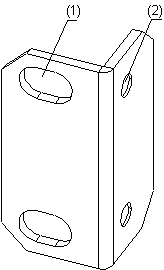
|
(1) Screw hole used to fix the mounting ear to the cabinet (Use one M6 screw) |
|
(2) Screw hole used to fix the switch to the mounting ear |
Figure 3-1 Appearance of a standard front mounting ear
Figure 3-2 shows the appearance of a rear mounting ear.
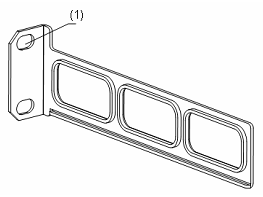
|
(1) Screw hole used to fix the mounting ear to the cabinet (Use one M6 screw) |
Figure 3-2 Appearance of a rear mounting ear
& Note:
The front mounting ears are included in the standard configuration package, and the rear mounting ears need to be ordered.
II. Introduction to guide rail
Figure 3-3 shows the appearance of a guide rail.
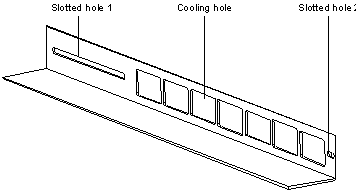
|
Slotted hole 1: Used to fix the guide rail to the rear bracket. You can adjust the screw hole position according to the position of the switch. |
|
Cooling hole: Used for heat dissipation between switch and cabinet |
|
Slotted hole 2: Used to fix the guide rail to the front bracket |
Figure 3-3 Appearance of a guide rail
& Note:
Guide rails need to be ordered.
III. Use front mounting ears and a tray
Follow these steps to install a switch into a 19-inch standard cabinet:
1) Wear an ESD-preventive wrist strap to check the grounding and stability of the cabinet.
2) Fix the delivered tray horizontally in a proper position.
3) Take out the screws which are packed together with the front mounting ears, and fix one end of mounting ears to the switch, as shown in Figure 3-4.

Figure 3-4 Fix front mounting ears
4) Place the switch on the tray horizontally, slide the tray into the cabinet, and fix the other end of mounting ears to the front brackets with crews and captive nuts, as shown in Figure 3-5.
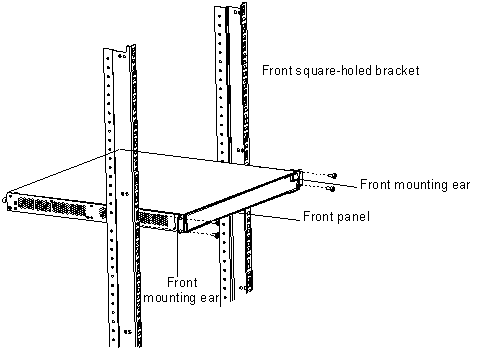
Figure 3-5 Fix front mounting ears and tray
IV. Use front and rear mounting ears
Follow these steps to install a switch into a 19-inch standard cabinet:
1) Wear an ESD-preventive wrist strap to check the grounding and stability of the cabinet.
2) Take out the screws which are packed together with the front mounting ears, and fix one end of mounting ears to the switch, as shown in Figure 3-4.
3) Take out the load-bearing screws (packed together with the rear mounting ears) and place them in a proper position on the sides of the switch, as shown in Figure 3-6.
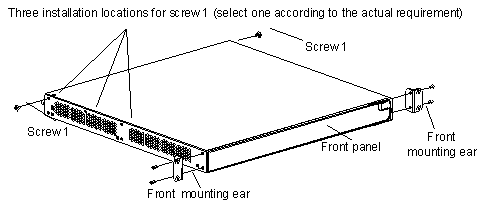
|
Screw 1: Load-bearing screw |
Figure 3-6 Fix front mounting ears and load-bearing screws
& Note:
There are three positions to mount a load-bearing screw on both sides of a switch. You should select a proper position according to the actual requirements. The rear mounting ears tightly contacted with the load-bearing screws can support the switch.
4) Select a position to install the switch and fix the rear mounting ears to the rear brackets with screws and captive nuts, as shown in Figure 3-7.
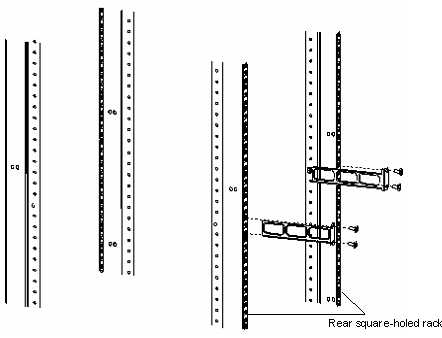
Figure 3-7 Fix rear mounting ears
5) Hold the bottom of the switch with one hand and the front part of the switch with the other hand, and push the switch into the cabinet gently, as shown in Figure 3-8.
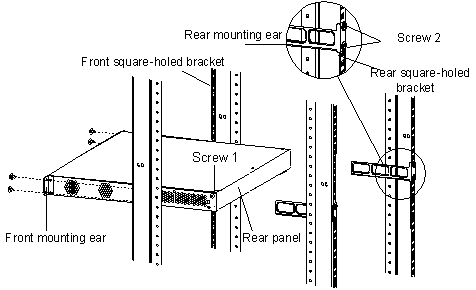
|
Screw 1: Used to bear the weight |
|
Screw 2: Used to fix rear mounting ears to rear brackets |
Figure 3-8 Fix front and rear mounting ears
After the switch is pushed into the cabinet, ensure that the upper edge of rear mounting ears is tightly contacted with the load-bearing screw, as shown in Figure 3-9.
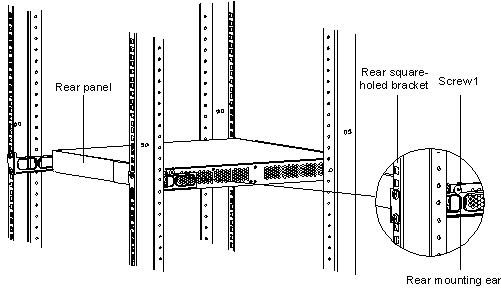
|
Screw 1: Load-bearing screw |
Figure 3-9 Effect diagram of front and rear mounting ear installation (1)
6) Fix the other end of the front mounting ears to the front brackets with screws and captive nuts and ensure that front and rear mounting ears have fixed the switch in the cabinet securely, as shown in Figure 3-10.
|
Screw 1: Load-bearing screw |
Figure 3-10 Effect diagram of front and rear mounting ear installation (2)
V. Use front mounting ears and guide rails
Follow these steps to install a switch into a 19-inch standard cabinet:
1) Wear an ESD-preventive wrist strap to check the grounding and stability of the cabinet.
2) Take out the screws packed together with the front mounting ears and fix one end of the front mounting ears to the switch, as shown in Figure 3-4.
3) Install guide rails on the brackets on both sides of the cabinet with M5 self-tapping screws, as shown in Figure 3-11.
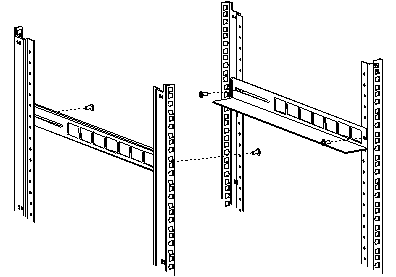
Figure 3-11 Install guide rails
4) Hold the two sides of the switch and slide it gently along the guide rails into the cabinet until it is located in a proper position, as shown in Figure 3-12. Ensure that the bottom side of the guide rails and the switch are in close contact.
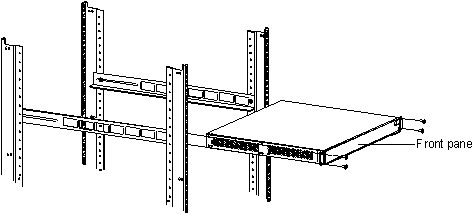
Figure 3-12 Install front mounting ears and guide rails
5) Fix the other end of front mounting ears to the front brackets of the cabinet with M6 screws and captive nuts and ensure that the front mounting ears and guide rails have fixed the switch in the cabinet securely, as shown in Figure 3-13.
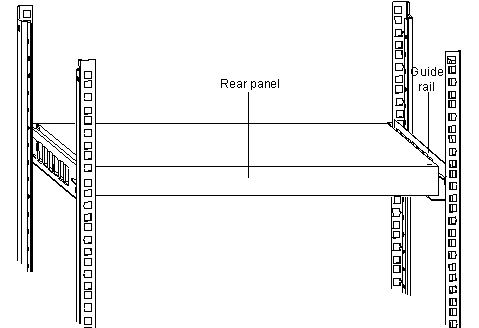
Figure 3-13 Effect diagram of front mounting ear and guide rail installation
& Note:
Ensure a clearance of 1U (44.45 mm, namely, 1.75 inches) between devices for the purpose of heat dissipation.
3.1.2 Desk Mounting
When a 19-inch standard cabinet is not available, you can simply place the switch on a clean desk. When doing so, you should ensure that:
l The desk is stable and well grounded.
l A clearance about 10 cm (3.9 in) is reserved around the switch for heat dissipation.
l No heavy object is placed on the switch.
3.2 Installing Power Module
![]() Caution:
Caution:
Do not touch any leads, terminals and parts marked with the hazard voltage label to avoid body harm.
3.2.1 Installing a Power Module
Step 1: Draw on the ESD-preventive wrist strap and ensure that the strap is well grounded.
Step 2: Remove the dummy panel from the power slot.
Step 3: Keeping the power module to be installed in the right direction, with one hand taking hold of the handle before the module and the other hand holding the module on the palm, smoothly slide the module into the power slot until the plug on the module completely fits into the socket in the chassis. Note that, the right direction is that the letters on the module is in the up direction; if you install the module with upset down, being restricted by the specially-designed structure inside the chassis, you will not be able to completely insert the module into the slot.
Step 4: Fasten the captive screws at both sides of the power module with a Phillips screwdriver.
3.2.2 Removing a Power Module
Step 1: Draw on the ESD-preventive wrist strap and ensure that the strap is well grounded.
Step 2: Power down the module to be removed.
Step 3: Loosen the captive screws at both sides of the power module with a Phillips screwdriver.
Step 4: With one hand taking hold of the handle before the power module to be removed and the other hand press down on the top of the switch, pull the module completely out off the socket in the chassis and smoothly out of the power slot.
![]() Caution:
Caution:
l The S5510 series supports the online-swap of power module. That is, you can install/remove a power module while keeping another power module operating in the switch.
l Before you install/remove a power module, you must first power down the module.
l When fasten the captive screws at both sides of the power module with a Phillips screwdriver or an electric screwdriver, keep the fixture moment less than 0.4 N•m.
l Properly preserve the dummy panel removed when installing a power module.
l To prevent dust from coming in and guarantee the normal ventilation of the switch, please install the dummy panel after removing the power module if you need not to install a new power module.
3.3 Connecting the Power Cord and the Ground Wire
3.3.1 Connecting the AC-Input Power Cord
I. AC-input power socket (recommended)
You are recommended to use a monophase three-line power socket with a ground contact or a general purpose PC power socket, making sure that the power point is well connected to building ground. Normally, the ground point of the power source in a building was buried in the ground during the construction and wiring. Still, you must make sure of that.
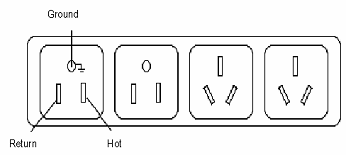
Figure 3-14 Power socket (recommended)
II. Connecting the AC-input power cord
Step 1: Connect one end of the chassis ground wire to the grounding screw on the rear of the chassis and the other end to the ground as near as possible.
Step 2: Connect one end of the power cord to the power socket on the rear of the chassis, and plug the other end to the AC power jack of the power source.
Step 3: Verify that the PWR LED on the front panel of the switch is ON.
![]() Caution:
Caution:
Before powering on the switch, connect the ground wire.
3.3.2 Connecting the DC-Input Power Cord
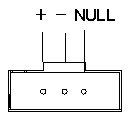
|
-: -48 to -60 V |
NULL: reserved |
Figure 3-15 DC-input power connector (partial)
Step 1: Connect one end of the chassis ground wire to the grounding screw on the rear of the chassis and the other end to the ground as near as possible.
Step 2: Directly insert the component into DC-input socket on the cabinet, and then fix the screws 1 and 2 carried by the connector itself to the appropriate holes on the cabinet socket using a small flathead screwdriver, see Figure 3-16.
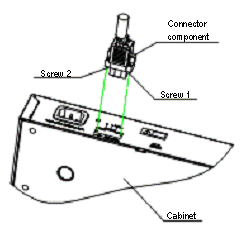
Figure 3-16 Illustration for fixing RPS connector to the cabinet
Step 3: Verify that the power LED PWR1/PWR2 on the front panel of the switch is ON.
![]() Caution:
Caution:
l Before powering on the switch, connect the ground wire.
l The length of the DC power cord must be less than 3 m (9.8 ft.).
3.3.3 Connecting the Ground Wire
![]() Caution:
Caution:
Correctly connecting the switch ground wire is crucial to the lightning protection and electromagnetic susceptibility (EMS) of a switch.
Ground your switch as follows:
l When a grounding strip is available at the installation site, attach one end of the yellow/green ground wire of the switch to the grounding screw on the grounding strip and fasten the captive nut. (Note that the fire main and lightning rod of a building are not suitable for grounding the switch. The ground wire of the switch should be connected to the grounding device for the equipment room.)
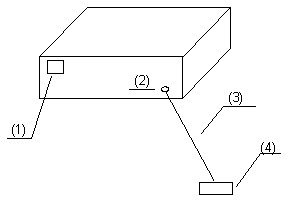
|
(1) Power input on the switch |
(2) Grounding screw on the switch |
|
(3) Ground wire |
(4) Grounding strip |
Figure 3-17 Grounding the switch through a grounding strip
l When there is no grounding strip but earth near the equipment room that allows a grounding body to be buried, hammer an angle iron/steel pipe longer than 0.5 m into the earth, weld the yellow-green ground wire of the switch onto the angle iron/steel pipe, and process the joint against erosion.
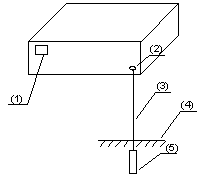
|
(1) Power input |
(2) Grounding screw |
(3) Ground wire |
|
(4) Earth |
(5) Angle iron |
|
Figure 3-18 Grounding the switch by burying the grounding body into the earth
l For an AC-powered switch, if none of the above two conditions is available, ground it through the PE wire of the AC power supply. In this case, make sure this PE wire is well connected to the ground at the power distribution room or AC transformer side.
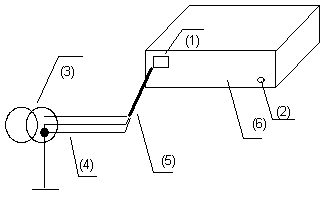
|
(2) Grounding screw |
(3) Power transformer |
|
|
(4) PE wire |
(5) AC-input (with 3-wire cable) |
(6) Ethernet switch |
Figure 3-19 Grounding through the AC PE wire
l For a DC-powered switch, if none of the first two conditions is available, ground it through the return wire (RTN) of the DC power supply. In this case, make sure this RTN wire is well connected to the ground at the DC output of the DC power cabinet.

|
(1) AC/DC power cabinet |
(2) -48V strip |
(3) -48V |
(4) RTN strip |
|
(5) RTN |
(6) PGND strip |
(7) Grounding |
(8) Ground wire |
|
(9) Grounding screw |
(10) Ethernet switch |
(11) DC-input |
|
Figure 3-20 Grounding through the PGND of a power cabinet
3.3.4 Multi-power Input
![]() Caution:
Caution:
The S5510 series switch can have both AC and DC power inputs, and both inputs must be disconnected when you power down your switch.
3.4 Connecting Optical Fiber
![]() Caution:
Caution:
l After a switch starts, the PON interface may emit invisible radial when there is no optical connector connected to it and the protective cap is removed from it. Therefore, do not stare into the optical interface.
l Be sure to cover the protective cap within 10 seconds if an optical connector is not in use to keep the optical connector clean.
l Be sure to cover the protective cap if a PON interface has no optical connector attached.
l Place the protective caps in a safe place when a PON interface has fiber connected to prepare for the cases the fiber is pulled out.
3.5 Connecting the Switch to a Console Terminal
3.5.1 Console Cable
Console cable is an 8-core cable. At one end of the cable is a crimped RJ-45 connector for the connection to the Console port of the switch; at the other end of the cable is one DB-9 (female) connector for the connection to the serial port on the console terminal. See Figure 3-21.

Table 3-1 Console cable pinouts
|
RJ-45 |
Signal |
Direction |
DB-9 |
|
1 |
RTS |
← |
7 |
|
2 |
DTR |
← |
4 |
|
3 |
TXD |
← |
3 |
|
4 |
CD |
→ |
1 |
|
5 |
GND |
–– |
5 |
|
6 |
RXD |
→ |
2 |
|
7 |
DSR |
→ |
6 |
|
8 |
CTS |
→ |
8 |
3.5.2 Connecting the Console Cable
Follow these steps to connect a terminal device, a PC for example, to the switch:
Step 1: Plug the DB-9 (female) connector of the Console cable to the serial port of the PC where the switch is to be configured.
Step 2: Connect the RJ-45 connector of the console cable to the Console port of the switch.
![]() Caution:
Caution:
Read the mark for the port to be connected carefully to make sure it is the right port.
& Note:
The serial ports on PCs do not support hot swapping. Therefore, do not insert or remove a serial interface cable from a PC that is connected to a switch with power. In connecting a PC to the switch, first connect the DB-9 connector of the console cable to the PC and then the RJ45 connector to the switch. In disconnecting them, remove the RJ-45 connector prior to the DB-9 connector.
3.6 Verifying Installation
l The correct power source is used.
l The ground wire is securely connected.
l Both of the console cable and power cord are correctly connected.
l All the interface cables are routed indoors. If there are cables outdoors, verify that the socket strip with lightning protection and lightning arresters for network ports have been correctly connected.
Chapter 4 Starting up the Switch at the Initial Boot
4.1 Setting up a Configuration Environment
Set up a configuration environment as shown in Figure 4-1.
Connect a terminal, a PC in this scenario to the Console port on the switch with a console cable.
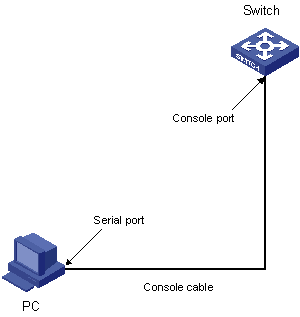
Figure 4-1 Network diagram for configuring the switch at initial boot
4.2 Connecting the Console Cable
Step 1: Connect the DB-9 female connector of the console cable to the serial port on the PC that is used for configuring the switch.
Step 2: Connect the RJ-45 connector of the console cable to the Console port on the switch.
4.3 Setting Terminal Parameters
Follow these steps to set terminal parameters on the PC (running Windows2000 for example):
Step 1: Start the PC and select [Start/Programs/Accessories/Communications/HyperTerminal].
The HyperTerminal window displays the Connection Description dialog box, as shown in Figure 4-2.
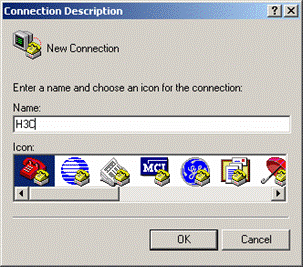
Figure 4-2 Setting up a new connection
Step 2: Enter the name of the new connection in the Name field and click <OK>. The dialog box, as shown in Figure 4-3 displays.
Step 3: Select the serial port to be used from the Connect Using dropdown menu. The serial port must be the same port connected by the console cable.
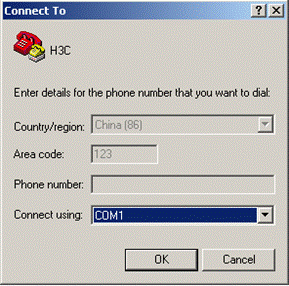
Figure 4-3 Setting the connection port
Step 5: Click <OK>. The Port Settings tab, shown in Figure 4-4, appears and you can set serial port parameters. Set the following parameters:
l Baud rate = 9600
l Data bits = 8
l Parity check = none
l Stop bits = 1
l Flow control = none

Figure 4-4 Setting communications parameters
Step 6: Click <OK>. The HyperTerminal dialogue box appears.
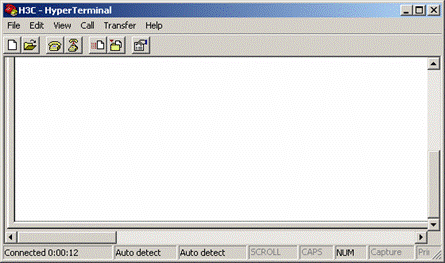
Figure 4-5 HyperTerminal window
Step 7: Select Properties.
Step 8: In the Properties dialog box, select the Settings tab, as shown in Figure 4-6.
Step 9: Select VT100 or Auto detect in the Emulation dropdown menu.
Step 10: Click <OK>.

4.4 Booting the Switch
4.4.1 Verifying Installation before Power-up
Before powering up the switch, verify that:
l Both the power cord and the grounding wire are correctly connected.
l Proper power supply is used.
l The console cable is correctly connected.
l The console terminal (or PC) has been started and the related parameters have been set on it.
4.4.2 Powering up the Switch
All the S5510 series Ethernet switches have the same BOOT ROM display style. This document takes the BOOT ROM display of the S5510-24P as example:
Starting......
*********************************************
* *
* H3C S5510-24P BOOTROM, Version 107 *
* *
*********************************************
Copyright(c) 2004-2006 Hangzhou H3C Technologies Co., Ltd.
Creation date : Apr 28 2006, 11:27:16
CPU type : MPC8241
CPU Clock Speed : 200MHz
BUS Clock Speed : 33MHz
Memory Size : 128MB
Initialize LSK1LTSU........................OK!
SDRAM fast selftest........................OK!
Flash fast selftest........................OK!
CPLD selftest..............................OK!
Switch chip selftest.......................OK!
Slot 0/25 has 1000BASE-LX-SMF module
Slot 0/26 has 1000BASE-LX-SMF module
Slot 0/27 has 1000BASE-LX-SMF module
Slot 0/28 has 1000BASE-LX-SMF module
PHY selftest...............................OK!
Please check port leds...............finished!
The switch Mac is: 000F-E200-5510
Press Ctrl-B to enter Boot Menu... 5
To enter the Boot Menu, press <Ctrl+B> within five seconds after the message “Press Ctrl-B to enter Boot Menu... 5” appears. Otherwise, when the waiting time changes from 5 to 0, the system automatically boots up and displays:
*********************************************************
* All rights reserved (2004-2006) *
* Without the owner's prior written consent, *
*no decompiling or reverse-engineering shall be allowed.*
*********************************************************
User interface aux0 is available.
Please press ENTER.
The appearance of “Please press ENTER” indicates that the switch has completed its automatic boot.
Press <Enter>; the system displays:
<H3C>
You can configure the switch now.
& Note:
A wide range of command views are available for H3C Series Switches. For more information on configuration commands and command line interfaces, refer to H3C S3610&S5510 Series Ethernet Switches Operation Manual and H3C S3610&S5510 Series Ethernet Switches Command Manual.
Chapter 5 Loading Boot ROM and Host Software
Switch software loading through serial ports in the past is time consuming and cannot be operated remotely. To address these problems, TFTP and FTP are used to allow software and file downloading through Ethernet ports. The following subsections describe how to load software and files in these two approaches.
5.1 Introduction to Loading Approaches
To load software remotely, use FTP or TFTP.
To load software at the local, use XModem at the Console port or TFTP/FTP at an Ethernet port.
& Note:
Ensure that the Boot ROM and host software versions that you download can work with each other.
5.2 Loading Software Locally
If your terminal is directly connected to the switch, you can load Boot ROM and host software locally. But before that, make sure they are correctly connected.
& Note:
The steps that you should take to load Boot ROM program and host software are the same, except that during Boot ROM program loading you need to press <Ctrl +U> after accessing the Boot ROM menu and will view different prompt information. Boot ROM loading procedures are described below for example.
5.2.1 Boot Menu
Starting......
*********************************************
* *
* H3C S5510-24P BOOTROM, Version 129 *
* *
*********************************************
Copyright(c) 2004-2007 Hangzhou H3C Technologies Co., Ltd.
Creation date : Apr 16 2007, 11:27:16
CPU type : MPC8241
CPU Clock Speed : 200MHz
BUS Clock Speed : 33MHz
Memory Size : 128MB
Initialize LSK1LTSU........................OK!
SDRAM fast selftest........................OK!
Flash fast selftest........................OK!
CPLD selftest..............................OK!
Switch chip selftest.......................OK!
Slot 0/25 has 1000BASE-LX-SMF module
Slot 0/26 has 1000BASE-LX-SMF module
Slot 0/27 has 1000BASE-LX-SMF module
Slot 0/28 has 1000BASE-LX-SMF module
PHY selftest...............................OK!
Please check port leds...............finished!
The switch Mac is: 000F-E200-5510
Press Ctrl-B to enter Boot Menu... 5
Press <Ctrl+B> as prompted. The system displays:
Password :
Input the correct Boot ROM password (no password is set by default). The system enters the following Boot Menu:
BOOT MENU
1. Download application file to flash
2. Select application file to boot
3. Display all files in flash
4. Delete file from flash
5. Modify bootrom password
6. Enter bootrom upgrade menu
7. Skip current configuration file
8. Set bootrom password recovery
9. Set switch startup mode
0. Reboot
Enter your choice(0-9):
5.2.2 Loading Software from Console Port Using XModem
I. Introduction to XModem
XModem is a file transfer protocol widely used for its simplicity and good performance. XModem transfers files through the Console port, supporting data packets of 128 bytes and 1 KB. With respect to reliability, it supports checksum, CRC, and the error packet retransmission mechanism. Normally, the maximum number of retransmission attempts is ten.
XModem transfer is completed by receiving and sending programs together. Receiving program initiates packet checking method negotiation by sending the negotiation character. If negotiation passes, the sending program starts packet transfer. Upon receipt of a complete packet, the receiving program checks it using the agreed-upon check method. If the check succeeds, the receiving program sends an acknowledgement character; if the check fails, it sends a reject character. Upon receipt of the acknowledgement, the sending program continues to send the next packet; upon receipt of the reject, it retransmits the packet.
II. Loading Boot ROM
Follow these steps to download the Boot ROM program:
Step 1: Enter <6> or <Ctrl + U> in the Boot Menu to access the Boot ROM loading menu shown below:
Bootrom update menu:
1. Set TFTP protocol parameter
2. Set FTP protocol parameter
3. Set XMODEM protocol parameter
0. Return to boot menu
Enter your choice(0-3):
Step 2: Enter <3> in the loading menu to download through XModem. The system displays the following download speed setting menu:
Please select your download baudrate:
1.* 9600
2. 19200
3. 38400
4. 57600
5. 115200
0. Return
Enter your choice (0-5):
Step 3: Choose an appropriate download baud rate. Enter <5> for example to download at 115200 bps. The system displays the following information:
Download baudrate is 115200 bps
Please change the terminal's baudrate to 115200 bps and select XMODEM protocol
Press enter key when ready
& Note:
You do not need to modify the HyperTerminal’s baud rate if you have chosen 9600 bps, and thus can skip Steps 4 through 6 and proceed to Step 7 directly. At this time, the system does not display the above information.
Step 4: Enter HyperTerminal’s [File/Properties] menu, click <Configuration> in the popup dialog box, select the baud rate of 115200bps in the Console Port Configuration dialog box.
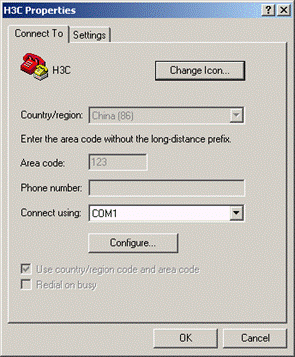
Figure 5-1 Properties dialog box
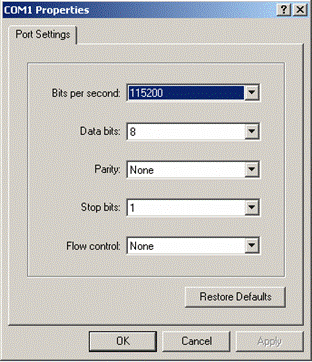
Figure 5-2 Console Port Configuration dialog box
Step 5: Click <Disconnect> to disconnect the HyperTerminal from the switch and then click <Call> to re-establish the connection, thus validating the baud rate setting.
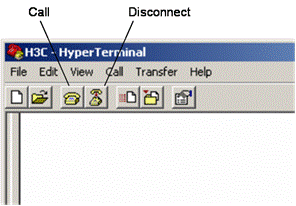
Figure 5-3 <Disconnect> and <Call> buttons
& Note:
After changing terminal’s baud rate, you must disconnect and connect the terminal emulation program to validate the new configuration.
Step 6: Press <Enter> to start program loading. The system displays the following information:
Now please start transfer file with XMODEM protocol.
If you want to exit, Press <Ctrl+X>.
Loading ...CCCCCCCCCC
Step 7: Select [Transfer/Send File] in the HyperTerminal’s window, and in the popup dialog box similar to the following figure click <Browse>, select the software you need to download, and set the protocol to XModem.
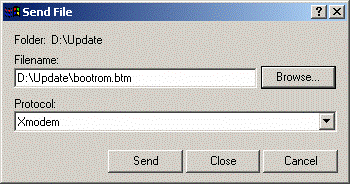
Figure 5-4 Send File dialog box
Step 8: Click <Send>. The system displays the following interface.
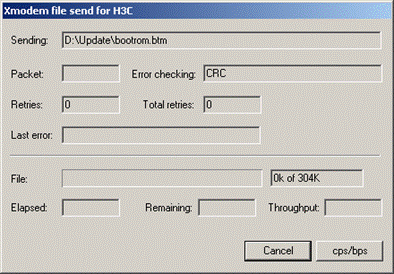
Figure 5-5 Sending File interface
Step 9: After completing loading, the system displays the following information:
Loading ...CCCCCCCCCC done!
& Note:
You do not need to reset the HyperTerminal’s baud rate and can skip the last step if you have chosen 9600 bps. In this case, the system does not display the above prompt message but “BootROM is updating now.....................................done” instead.
Step 10: Reset HyperTerminal’s baud rate to 9600bps with reference to Steps 5 and 6 described above. Then, press any key as prompted. The system will display the following information when it completes the loading.
Loading........................done
Bootrom is updating now......
Download bootrom to flash
Erasing flash......done!
Programming flash......done!
Checking flash......done!
III. Loading host software
Follow these steps to download host software of the switch:
Step 1: Select <1> in the Boot Menu. The system displays the following information:
1. Set TFTP protocol parameter
2. Set FTP protocol parameter
3. Set XMODEM protocol parameter
0. Return to boot menu
Enter your choice(0-3):3
Select <3>. The subsequent steps are the same as those for loading Boot ROM, except for the program to be downloaded in prompt messages.
5.2.3 Loading Software from an Ethernet Port Using TFTP
I. Introduction to TFTP
Trivial File Transfer Protocol is a TCP/IP protocol used for file transfer between clients and servers. It uses UDP to provide unreliable data stream transfer service.
II. Loading Boot ROM
Step 1: Select an Ethernet port on the switch for loading and connect it to the PC where the file to be downloaded is stored. (You must know PC’s IP address). Besides, connect the Console port on the switch to an external PC. This PC can be the same one that stores the file to be downloaded.
Step 2: Run the TFTP Server program on the PC connected to the Ethernet port, and specify the path for program loading.
![]() Caution:
Caution:
TFTP Server program is not provided with the H3C Series Switches.
Step 3: Run terminal emulation program on the PC that is connected to the Console port. Start the switch, access the Boot Menu, and then enter the download protocol menu.
To download the Boot ROM program, enter <6> or <Ctrl + U> to access the menu for Boot ROM downloading when the system displays: “Enter your choice(0-9):”
Bootrom update menu:
1. Set TFTP protocol parameter
2. Set FTP protocol parameter
3. Set XMODEM protocol parameter
0. Return to boot menu
Enter your choice(0-3):
Step 4: In the download protocol menu, press <1>to select TFTP protocol to download Boot ROM or host software. Press <Enter>. The system displays the following information:
Load File name
Switch IP address ¬(This address and the server IP address must be on the same network segment)
Server IP address ¬ (IP address of the PC where the file is stored)
Step 5: Input the TFTP parameter values and press <Enter>. The system displays the following information:
Are you sure to update your bootrom?Yes or No(Y/N)
Step 6: Press <Y> to start file downloading and <N> to return to the program downloading menu. Suppose you press <Y> and then <Enter>. The system starts Boot ROM program downloading and automatically starts Boot ROM loading. After finishing loading, it displays the following information:
Loading........................done
Bootrom is updating now......
Download bootrom to flash
Erasing flash......done!
Programming flash......done!
Checking flash......done!
III. Loading host software
Follow these steps to download host software of the switch.
Step 1: Select <1> in the Boot Menu. The system displays the following information:
1. Set TFTP protocol parameter
2. Set FTP protocol parameter
3. Set XMODEM protocol parameter
0. Return to boot menu
Enter your choice(0-3):3
Select <1>. The subsequent steps are the same as those for loading Boot ROM, except for the program to be downloaded in prompt messages.
5.2.4 Loading Software from an Ethernet Port Using FTP
I. Introduction to FTP
With an Ethernet port, you can also use the switch as the FTP server or client to download or configuration files. The following subsections describe how to load software by using the switch as the FTP client for example.
II. Loading Boot ROM
& Note:
In the process of loading Boot ROM, the switch can only act as the FTP client.
Step 1: Select an Ethernet port on the switch for loading and connect it to the PC where the file to be downloaded is stored. (You must know PC’s IP address). Besides, connect the Console port on the switch to an external PC. This PC can be the same one that stores the file to be downloaded.
Step 2: Run the FTP Server program on the PC that is connected to the Ethernet port, and specify the path for program loading.
Step 3: Run terminal emulation program on the PC connected to the Console port. Start the switch, access the Boot Menu, and then enter the download protocol menu.
To download the Boot ROM program, enter <6> or <Ctrl + U> to access the menu for Boot ROM downloading when the system displays: “Enter your choice(0-9):”
Bootrom update menu:
1. Set TFTP protocol parameter
2. Set FTP protocol parameter
3. Set XMODEM protocol parameter
0. Return to boot menu
Enter your choice(0-3):
Step 4: In the download protocol menu, press <2> to select FTP protocol to download Boot ROM and host software. Press <Enter>. The system displays the following information:
Load File name
Switch IP address ¬(This address and the server IP address must be on the same network segment)
Server IP address ¬(IP address of the PC that stores the file)
FTP User Name
FTP User Password
Step 5: Input the FTP parameter values and press <Enter>. The system displays:
Are you sure to update your bootrom?Yes or No(Y/N)
Step 6: Press <Y> to start file downloading and <N> to return to the program downloading menu. Suppose you press <Y> and then <Enter>. The system starts program downloading and upon its completion, starts writing to Flash. After completing the writing operation, the system displays:
Loading........................done
Bootrom is updating now......
Download bootrom to flash
Erasing flash......done!
Programming flash......done!
Checking flash......done!
III. Loading host software
Follow these steps to download host software:
Step 1: Select <1> in the Boot Menu. The system displays:
1. Set TFTP protocol parameter
2. Set FTP protocol parameter
3. Set XMODEM protocol parameter
0. Return to boot menu
Enter your choice(0-3):3
Select <2>. The subsequent steps are the same as those for loading Boot ROM, except for the program to be downloaded in prompt messages.
5.3 Loading Software Remotely
If your terminal is connected to the switch by a network, you can load Boot ROM and host software remotely.
5.3.1 Loading Software Remotely Using FTP
Run FTP server on a local PC, provided you have configured username and password and have set the correct file directory. Suppose IP address of the PC is 10.10.110.1. Telnet to the switch and FTP the host program to the switch.
Provided that the host program is SWITCH.bin and the Boot ROM program is SWITCH.btm, you can take these steps after telneting to the switch.
Step 1: FTP the software to the switch.
<H3C> ftp 10.10.110.1
Trying ...
Press CTRL+K to abort
Connected.
220 WFTPD 2.0 service (by Texas Imperial Software) ready for new user
User(none):lyt
331 Give me your password, please
Password:
230 Logged in successfully
[ftp] get SWITCH.bin SWITCH.bin
[ftp] get SWITCH.btm SWITCH.btm
[ftp] bye
Step 2: Load Boot ROM.
<H3C> boot bootrom SWITCH.btm
This will update BootRom file on board 0 . Continue? [Y/N] y
Upgrading BOOTROM, please wait...
start enter the Drv_BootromUpdate
Upgrade BOOTROM succeeded!
Step 3: Load the host software.
<H3C> boot boot-loader SWITCH.bin
The specified file will be booted next time!
<H3C> display boot-loader
The app to boot at the next time is: flash:/SWITCH.bin
<H3C> reboot
& Note:
The configurations that you make cannot survive a reboot. Make sure you have saved them before you have the system reboot.
To validate the downloaded Boot ROM and host software, you must reboot the switch. In case of inadequate Flash memory space, you can delete some of the program files in Flash, those that are no longer in use for example, after completing Boot ROM loading. Then FTP the host program to the switch.
& Note:
Power disconnection must be prevented during the loading process.
5.3.2 Loading Software Remotely Using TFTP
TFTP is similar to FTP in remote software downloading. But with TFTP, the switch can only be used as the client to download software to its Flash memory from the TFTP server. After that, the remaining steps are the same as remote loading using FTP.
Chapter 6 Maintenance and Troubleshooting
6.1 Dealing with Loading Failures
If software loading fails, the system operates with the original version.
To address the failure cause, take these steps:
1) Verify that the physical ports are correctly and securely connected. If they are not, reconnect them correctly and restart loading.
2) Check information about the loading procedures for input errors on the HyperTerminal.
l If XModem is used, verify that you have reset the baud rate of the HyperTerminal to 9600 bps after loading the software with another baud rate.
l If TFTP is used, verify that you have correctly specified the TFTP parameters: server and switch IP addresses; name of the software to be loaded; and path for the TFTP server to operate on program files.
l If FTP is used, verify that you have correctly specified the FTP parameters: server and switch IP addresses; name of the software to be loaded; and username and password.
3) Contact your sales agent for help if you cannot address the problem after taking the preceding two steps.
6.2 Dealing with Password Loss
6.2.1 Dealing with User Password Loss
If you lost your user password, enter the Boot Menu first:
BOOT MENU
1. Download application file to flash
2. Select application file to boot
3. Display all files in flash
4. Delete file from flash
5. Modify bootrom password
6. Enter bootrom upgrade menu
7. Skip current configuration file
8. Set bootrom password recovery
9. Set switch startup mode
0. Reboot
Enter your choice(0-9):
Select <7> and have the switch reboot. The user password is deleted at the reboot to allow you access the switch without password.
6.2.2 Recovering the Boot ROM Password
Contact your sales agent for help.
6.3 Dealing with Power System Failures
You can know whether the power system has failed by reading the power LED (PWR) on the front panel. If the power system is operating normally, the power LED is constant ON. If not, verify that:
l The switch power cord is correctly connected.
l The power source can work with the switch.
6.4 Dealing with Configuration System Failures
If the switch is operating normally after it is powered up, it displays the start-up information on the console terminal. If the configuration system has failed, it displays illegible characters or nothing at all.
I. No information on the terminal
Take these steps to address the problem:
1) Verify that:
l The power system is operating normally.
l The console cable is connected correctly.
2) Verify that the console cable is in good condition and the terminal (HyperTerminal for example) parameter settings are correct.
II. Illegible characters on the terminal
Make sure you have set on your terminal (HyperTerminal):
Baud rate = 9600
Data bits = 8
Parity check = none
Stop bits = 1
Flow control = none
Terminal emulation = VT100
Reconfigure the parameters if their values are different.

